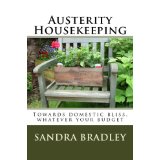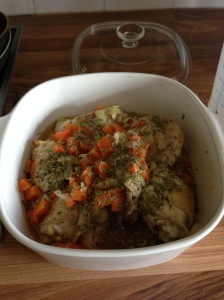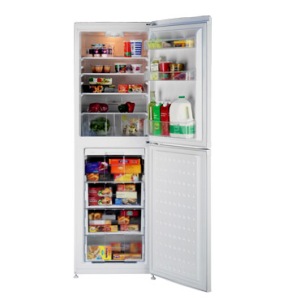Austerity Housekeeping eBook available on Amazon FREE OVER BANK HOLIDAY WEEKEND!
If you want to download the eBook version of this blog, so you can wander around with it  on your phone or whatever, Amazon are offering it FREE over the bank holiday weekend from Saturday 27th August to Tuesday 30th August, and after that for £1.99/$2.99 USD. Just click here. http://www.amazon.co.uk/Austerity-Housekeeping-Sandra-Bradley-ebook/dp/B00ASDW1U6/ref=sr_1_1?ie=UTF8&qid=1396735758&sr=8-1&keywords=austerity+housekeeping
on your phone or whatever, Amazon are offering it FREE over the bank holiday weekend from Saturday 27th August to Tuesday 30th August, and after that for £1.99/$2.99 USD. Just click here. http://www.amazon.co.uk/Austerity-Housekeeping-Sandra-Bradley-ebook/dp/B00ASDW1U6/ref=sr_1_1?ie=UTF8&qid=1396735758&sr=8-1&keywords=austerity+housekeeping
You can read the book on a Kindle, iPad, iPhone or PC just by downloading the Kindle App, which is free. If you do download the book, it would be great if you could leave a review on the Amazon site. Every review helps to build the Austerity community.
Five ways to supercharge your energy saving

Energy prices are rocketing in the UK, and for many people it is a pretty desperate state of affairs. Here are some new things to get in place over the summer, to offset the increasing winter costs that are facing us all.
- Install reflective panels behind all your radiators. Rather than heating the street, you might want to put insulation material behind your radiators to reflect the heat back into the room. This comes in number of different forms. The cheapest method is to cover pieces of cardboard with kitchen foil and slot them into place over the brackets. The problem with this is that is the effectiveness can degrade over time, and there is an increased fire risk. An alternative option is to buy rolls or sheets of bubble foil from DIY stores, or online, and cut this to fit, before using adhesive strips to fit it to the wall. This works better, but the bubble element is something of a gimmick as it only really works when there is a lot of air circulation, which given that it will be trapped between a wall and a metal object, will limit its usefulness. Normal padded radiator foil is better, fixed with double-sided tape, and you can order this from Screwfix. https://www.screwfix.com/p/radiator-reflector-foil-470mm-x-4m-1-88m/88629?cm_sp=managedredirect--plumbing--radiatorfoil&_requestid=315930. An even better solution is going to be something like Radflek, which is a more sophisticated solution with a variety of fitting options. These are sheets which can be cut to fit, and come in different sized packs. www.radflek.com. All of these products will pay for themselves quickly before the end of the year.
- Look at your water consumption and make adjustments. This might feel like it has nothing to do with energy costs, but reducing the amount of water you use, particularly heated water, can make a difference to both utility bills. If you visit the Get Water Fit website, you will be able to calculate your water usage, see where you can make savings, and more excitingly, order loads of FREE water saving gadgets and products from your local water company that might help save money (such as shower timers, smart shower heads, toilet leak detectors and tap aerators). https://www.getwaterfit.co.uk/#/
- Make your smart meter work harder for you. If you have a smart meter, try using an app such as Loop to help identify where your money is going. For example, are you leaving gadgets on overnight without realising? Most people manage to save 10% on their energy bill this way. https://loop.homes/
- Try a heated airer for laundry. Most people will be familiar with using a rotary airer for laundry during good weather, but what happens when it’s damp and rainy? Here is when a heated clothes airer can help. They cost about 15p-20p an hour to run and if you throw a fitted sheet over the whole thing once the washing is all hung up, it will dry even quicker (so you don’t need to buy a special cover). The Lakeland Dry:Soon range is very popular, but their cheapest airer costs £119.99 https://www.lakeland.co.uk/25904/dry-soon-mini-3-tier-heated-airer. You can get a fairly large alternative from John Lewis for £100 https://www.johnlewis.com/john-lewis-3-tier-heated-indoor-clothes-airer/p2427279 and Argos have a smaller one for £59.99 https://www.argos.co.uk/product/7076006
- Keep a flask near your kettle for surplus hot water, so you boil the kettle less. If you are working from home, this will mean you can make a cuppa quicker while saving money too, once you get used to it. Work to make it an automatic habit.
- Use plasma technology to clean your clothes, to save putting the washing machine on! The Bosch FreshUp isn’t cheap, at £199.99, so it’s not exactly an austerity item, but it can remove smells effectively from clothes (not stains). This means you are able to wash clothes less often and also reduce dry cleaning bills. As running the washing machine is now approaching between £1-£2 a wash, plus the hassle factor of folding and drying everything, plus associated ironing time and costs for smarter items, plus £5-£10 for periodically dry cleaning things like jackets, school blazers and coats, this might be worth considering if you have that kind of laundry to get through. Maybe do the sums and see if it pays off for you. https://www.bosch-home.co.uk/bosch-innovations/freshup-fabric-refresher
Your freezer can be your best friend
This week I’m looking at how to stock up your freezer to make family meals easier. If you aim at making sure the freezer is fully stocked at all times, it’s cheaper to run. The list below means you will have a varied selection of useful foods that will last you about a week if you aren’t able to get out shopping in the colder weather. I have included instructions on defrosting as well, as many people are nervous about what you can and can’t get away with. Basically if you are particularly careful about shellfish and poultry, and make sure all foods are thoroughly cooked through before eating, then you should be fine.
If you haven’t got a freezer, chest freezers are the cheapest to buy and can be bought quite cheaply second hand as not much tends to go wrong with them.
One thing to avoid is tucking lots of unlabelled tubs and plastic bags full of leftovers in there, however, otherwise your heart will sink every time you open the door. Aim to keep a lot of basics in stock so you can use them as a basis for proper meals. Try cooking some home-made ready meals if you like, but do label them with the name of the recipe, date, and cooking instructions so family members bother to use them.
MEAT AND FISH
Pork chops/Steaks
Defrost overnight or soak in a bowl of cold water for 30-60 minutes until floppy. Grill or bake in the oven until cooked through.
Beef mince
Can be cooked from frozen by breaking it up and turning it over repeatedly whilst heating in a frying pan. Must be completely brown before you eat it.
Prawns
Must be thoroughly defrosted before use. Can be defrosted in a bowl of cold water before use, or in the fridge overnight (minimum of 10 hours). Can then be added to pasta sauce, curry sauce or fried with butter, lemon and herbs. Also useful for stir fries.
Seafood mix
Must be thoroughly defrosted before use. Can be defrosted in a bowl of cold water before use, or in the fridge overnight (minimum of 10 hours). Can then be added to pasta sauce, curry sauce or fried with butter, lemon and herbs. Also useful for fish soup – cook with chopped onion, tins of chopped tomatoes and 1-2 cloves crushed garlic.
Chicken or poultry portions
Must be thoroughly defrosted before use . Defrost in the fridge overnight or for 10 hours. Do not take short cuts. Grill or bake in the oven until thoroughly cooked through.
Sausages
Defrost overnight or soak in a bowl of cold water for 30-60 minutes until floppy. Grill or bake in the oven until cooked through.
Fish fillets
Can be cooked from frozen. Grill or bake in the oven until cooked through. Can also be microwaved, allow about 1-2 minutes per fish.
FRUIT, VEGETABLES AND POTATOES
Cook from frozen, or follow the instructions on the packet.
Roast potatoes
Potato and vegetable mix
Peas
Brocolli
Spinach
Packet of frozen raspberries or forest fruits
GENERAL
Ham
Defrost in the fridge overnight or for a minimum of 10 hours before use. Do not take short cuts.
Hard cheese
Defrost in the fridge overnight or for a minimum of 10 hours before use. Grated cheese can be used from frozen.
Olive or sunflower spread
Defrost in the fridge for half a day minimum, until it is spreadable.
Butter
Defrost in the fridge for half a day minimum, until it is spreadable. Can be used from frozen, if you can!
Pizza
Cook from frozen according to the instructions on the packet.
Vanilla ice cream
Good as a dessert topping instead of cream
BAKERY
Bread
Can be reheated in the oven (20 minutes, watch it doesn’t burn) or in slices in the toaster.
Rolls
Can be reheated in the oven (20 minutes, watch it doesn’t burn) or in slices in the toaster.
Cakes and buns
Defrost for about four hours, or in an emergency reheat in the oven as for bread and rolls.
Strudel
Cook from frozen, follow instructions on the packet.
Family cycling during the fuel crisis
Here’s a simple check list for getting your bike up and running now so you can save fuel and get a bit of exercise as a family.
You will need
A pump that actually fits your tyres. This might have a little tube thing that comes out of the end and screws onto both the wheel and the pump, in which case it’s designed for a Schrader valve. If you need to screw the pump straight onto the wheel, and there’s no removable tube thing, it’s called a Presta valve. Some pumps will have an adaptor so they can be used for both types of valve. Keep it handy in your hallway or garage.
Some WD40 spray oil in a can, or cycle oil.
Batteries for your lights.
A cycle tool or set of hex keys and spanners to fit your bike.
A bucket of warm water, a cleaning cloth, non stick pan scrub and some Cif.
How to do it
1. Wipe down the main areas of your bike with the Cif to remove any mud. Avoid cleaning the chain. Rinse, and polish dry.
2. Tighten up anything that appears to be rattling, reposition anything that seems to be rubbing on things that it shouldn’t. For example, if your brakes are squeaky, it may be that they have got knocked and just easing them to a central position will solve the problem, adjusting the brake pads carefully so they don’t touch the rim of the wheel when in motion, but are near enough to do so if you decide to brake. If your mud guards are rattling, again, ease them into a central position or tighten up any nuts. If your seat or handlebars don’t feel completely secure, a couple of twists with a spanner should do it.
3. Pump up your tyres so you can only just press your thumb into the top where the tread is once they are fully inflated. Don’t overfill them, otherwise the inner tube will burst. If you underinflate them, you will wear the inner tube out. Get into the habit of pumping them up at least two to three times a week for optimum performance. Carry a small pump with you when cycling for emergencies.
4. Replace the batteries in your lights so they are ready for use and don’t run out unexpectedly.
5. Give the chain a couple of drops of oil, or a spray or two of WD40. You might also do this for your bicycle lock.
Organising family cycling – top tips
Make sure everyone has a parcel carrier and/or a basket so they can carry their own gear, however young they are. Even our smallest child used to have a basket on the front of his Postman Pat tricycle for his cagoule and teddy.
Teach children independence by getting them to lock up their bikes safely and securely (so they don’t fall over or get knocked) whenever they park them, and attaching the locks to holders on their bikes when they are riding them. Combination locks can be a little unreliable but are easy for children to use, and can be complemented with an adult D-lock on family trips, when you can lock several bikes together.
Have a box with spare pumps, light, batteries and basic repair kit readily to hand, so you can easily repair things if you are in a hurry. There’s nothing worse than embarking on a trip out only to realise someone has a flat tyre, or that another family member has lost the only pump.
Make friends with your local bike repair person so they are more willing to mend a flat tyre for you in a hurry.
Children always need to wear helmets, even on bike paths, as they come off more often and hit their heads, and their skulls are soft. Adults need to wear helmets in traffic, or when doing sports cycling, or if unsteady, but statistically are more likely to break an arm or a leg in other cycling accidents, so strictly speaking have more of a choice in whether a helmet is truly necessary for them, depending on a risk assessment of the cycling conditions. Keep your family cycle helmets on a shelf in a row or hanging from a row of hooks, so they are easily accessible.
Image courtesy of http://www.metalcowboy.com/presskit.shtml
Chicken and tarragon in the slow cooker
Recently I adopted what can only be described as a deliciously retro slow cooker from a relative. With its orange plastic exterior and its Dow Corning cookware heating and serving dish, it’s a real blast from the past. Today’s recipe uses some cheap chicken portions on special offer at Sainsbury, and turns them into something really tasty for supper. The slow cooker is a wonderful tool for busy parents, as you can brown a bit of meat in the morning, add some stock and vegetables, and leave it bubbling away all day so you come home to a restaurant standard meal without much effort at all. Serve this recipe with rice and some steamed spring greens. Remove chicken from the bone and add 100g pearl barley an hour before the end of cooking, if you would like it to become a one-pot meal (it will resemble a fabulously unusual risotto). You can also stick it in a pie dish and put a pastry lid on it, to make a quick pie, or alternatively it would make a savoury crumble if you rubbed flour and sunflower margarine together, added a few oats, and seasoned it with salt and pepper before sprinkling over the stew and baking in the oven for 20 minutes,
Slow Cooker Chicken and Tarragon








Christmas leftovers
Here are some ideas for using leftovers in a simple, imaginative way. For more, see http://tinyurl.com/zodf8st
Christmas pudding ice cream
Mix leftover custard with equal amount of double cream and stir in crumbled leftover Christmas pudding. Put in the freezer for 2 hours, then take out and stir before putting back into the freezer overnight. Take out an hour before serving. Tastes like rum and raisin ice cream, and great with a dash of Bailey’s over the top.
Vegetable stock
Boil turkey carcass in 2 litres of water with 2 sticks of celery, 2 peeled onions chopped in half, and 2 carrots, for about an hour. Strain into bowl and then pour into plastic containers for storage in fridge or freezing. Use for soup, stews or gravy.
Turkey and banana balls ( baby or toddler food)
Steam an unpeeled banana. Chop a few teaspoons of leftover turkey in a food processor and add the banana and a little butter. Remove the mixture and roll into little balls to make finger food for a baby or toddler.
Hot winter fruit salad
Boil satsuma or clementine slices in water, a little sugar and a bit of brandy or Cointreau if you have some to hand, along with anything to hand such as dates, grapes, and dried fruits. Serve with cream or ice cream.
Chestnut and coffee mousse
Mix together leftover chestnut puree, a small amount of instant coffee to taste, and double cream in a food processor or blender until the cream has thickened. Sweeten with vanilla sugar.
Image: http://120dollarsfoodchallenge.com/2010/12/22/leftover-lottery-reader-suggestions/
Planning for Christmas 3 – Presents, cards and wrapping
For Christmas stockings, you can do a lot worse than raid the pound shop from about October onwards, allowing the same number of presents per child to avoid arguments. Babies’ stocking fillers can be bought from school fetes or jumble sales and cleaned up in the washing machine or dishwasher (I filled a first Christmas stocking for £2 once this way). In terms of main presents for children, it’s difficult to deal with the marketisation of childhood and retain your sanity in the festive season, but it might help to chant these phrases in your head like a mantra when the going gets tough.
- Toys are not evidence of parental affection.
- Toys are not a substitute for parental time.
- There’s no sense in having so many toys to play with you can’t choose what to do.
- The more toys they have, the more we have to tidy away.
- Most children play with 20% of their toys 80% of the time.
- It’s just too expensive and that’s that.
For adults, it’s sensible to set a ceiling of £5 or £10 so the present buying doesn’t get competitive or out of hand. It’s better to have a single, thoughtfully chosen gift that makes you smile when you think about it, than a clutch of things that have been given to you for the sake of it, and which you will forget shortly afterwards.
Wrapping
Make or reuse gift bags, which can be fiercely expensive if bought new. For wrapping paper, use brown paper sponged with gold, bronze and silver paint, or stamped with a gold Christmas motif of some kind. Finish off with gold ribbon. Or leave the brown paper plain and use country-style tartan ribbon instead. Iron previously used tissue paper on a very low heat with the steam turned off, and use it with simple paper or raffia ribbons. This can also be a good way of packaging gifts attractively whilst keeping down your carbon footprint and costs. Finally, make your own gift tags out of coloured card cut to look like a parcel label, tied with paper ribbon, raffia or string. Or cut out motifs from old Christmas cards and stick onto plain white card for a different effect.
Home made presents
Think about producing some of the following as presents with enhanced personal involvement.
- Jams and jellies, including from foraged food as in previous posts.
- Truffles and nut crunch in cellophane bags with Christmas ribbon.
- Shortbread biscuits
- Miniature muffins, cookies or chocolate brownie bites. (My neighbour Cornelia brings a bag of home made toll house cookies with her every New Year’s Day when she comes to visit, and there is invariably an undignified fight over them, as they are so glorious).
- Boiled fruit cake baked in a circle and put in a festive tin.
- Home made gift vouchers for babysitting, dog grooming, car valeting, beauty treatments, cooking, or whatever you are good at.
- Christmas greens such as ivies and holly, tied decoratively with raffia.
- Create stationery kits for young children by sticking on colourful scrapbook or gift wrap paper onto the front of a basic notebook, and then adding pencils, ruler, rubbers, sharpeners and so on in matching colour, presenting in a cellophane bag with a toning ribbon.
- Canvas shopping bags (available for a euro in most of Europe) with iron on names and pictures, for children to use to store their library books, so they don’t get lost.
- For cards, buy packets of 50 plain cream cards and envelopes, and make your own stamped design. Write the greeting inside in fountain pen, very elegantly. It may not be cheaper than cards from the pound shop, but it will be more thoughtful.
Planning for Christmas 2 – Decorations
 It’s pretty straightforward to decorate your house so it looks welcoming and festive without going mad in the artificial environment of the Christmas displays in department stores. Try these suggestions for cheap and cheerful displays.
It’s pretty straightforward to decorate your house so it looks welcoming and festive without going mad in the artificial environment of the Christmas displays in department stores. Try these suggestions for cheap and cheerful displays.
- Popcorn chains – Follow an air-popped popcorn recipe and thread pieces onto a long red thread. These can be draped over Christmas trees or hung in windows.
- Gingerbread ornaments – Make up a batch of gingerbread dough and cut out using Christmas cutters, making a hole at the top before baking ready for a ribbon to be threaded through later on. You can also ice them with coloured writing icing once they are cooled.
- Paper chains – Cut strips of coloured paper so they are about 15-20cm long. Make a loop of the first one, and glue closed with Pritt stick. Thread a second strip through this, and close the loop with Pritt stick once again. Carry on until the chain is long enough to hang across a room. Several of them can be used for a more elaborate effect. Children often enjoy helping to make these.
- Cinammon sticks – Tie bundles of cinnamon sticks together with ribbon and use to adorn Christmas trees, by securing with craft wire.
- Snow – Using the cheapest cotton wool you can lay your hands on, stretch in the window to create the effect of snow. This also works for cobwebs around Halloween time.
- Snowflakes – This is another good project for children. Cut white or silver paper into squares about 15cmx15cm, and then fold into quarters. Cut an arc around the edge so you get a circle, and then snip out little pieces around the edge and on the folds so that when you open it out you get a snowflake pattern. These look good on the Christmas tree.
- Wreaths – Make a loop of chicken wire, and then tie evergreens and clusters of berries from the garden onto it, until the wire is obscured. You can also use florist’s wire or a hot glue gun to secure things like apples, nuts, oven dried slices of orange, and cinnamon sticks. Spray with hairspray to preserve the wreath (which will need keeping away from fire afterwards). Then add a wide tartan ribbon at the top to make a hanging loop.
Planning for Christmas 1 – Christmas Dinner
 It’s quite possible to spend so much on Christmas that you are still paying for it at Easter or even by the summer. This seems a bit pointless, as it’s quite possible to rein things in so that the meaning of Christmas is there without the financial hangover afterwards. Ideally you should have been putting away 1/12 of your spare income each month with the festive season in mind. We’ll start with planning for a good but economical Christmas dinner.
It’s quite possible to spend so much on Christmas that you are still paying for it at Easter or even by the summer. This seems a bit pointless, as it’s quite possible to rein things in so that the meaning of Christmas is there without the financial hangover afterwards. Ideally you should have been putting away 1/12 of your spare income each month with the festive season in mind. We’ll start with planning for a good but economical Christmas dinner.
Turkey – Fresh is nice, and makes it easier to avoid food poisoning as it doesn’t need defrosting, but if funds are tight, choose a frozen bird but plan ahead carefully and allow it to defrost properly (See the British Turkey website at http://www.britishturkey.co.uk/cooking/cooking-calculators.html for a clever online tool to help you calculate the time required, but you should be allowing as long as 120-144 hours to defrost a 12 pound turkey in the fridge, for example, or 36-48 hours in a cool room or garage, and 24 hours at room temperature. If you are really struggling financially, turkey joints provide a tasty alternative, as do large chickens. If you are having a cheaper turkey, add flavour by putting an onion into the cavity, as well as strips of bacon over the breast, before covering with a double layer of foil and cooking.
Vegetables – Again, if you can’t afford fresh, or haven’t got a lot of time to prepare on the day, then go for frozen, as they have all of the vitamins and fibre and the family will hardly notice.
Stuffing – Try putting the following into a blender to make your own stuffing: a few pieces of stale bread, a handful of sage leaves out of the garden, a sliced onion, some salt and pepper, an egg, a little milk if it seems quite dry. Blend on high for a minute until it is all mixed up, and then take out and place in a loaf tin, use to stuff your bird, or roll into little balls and bake on a baking sheet covered with parchment.
Sausage and bacon rolls – The frozen ones are fairly indistinguishable from fresh once cooked, and can be bought from mid-Autumn onwards when there is a special offer.
Christmas pudding – The cheaper ones are surprisingly good, and I have it on good authority that some restaurants have been known to buy these from leading supermarkets and serve them as their own. Serve with cream for minimum effort, or Sweet white sauce (see recipe elsewhere on blog) or custard.
Cranberry sauce – Again, the cheaper brands are often perfectly acceptable. A dollop of red wine or port and a bit of orange zest will bring them to life.
Boxing Day Sales! Stock up your present cupboard
With a lot of sales starting today, it’s a good time to start thinking about next year’s birthday presents and parties and stocking up your supplies. This means you won’t end up spending more than you need to on a last minute present in a panic. Here are some gifts for under-fives that hopefully won’t duplicate existing toys and which only cost a couple of quid. Remember to stock up on wrapping paper and cheap cards at the same time!
One-year-olds – Card books, posting and stacking toys, balls, simple bucket and spade set for the local sandpit.
Two-year-olds – Colourful sports drinking bottles, fizzy bath tablets, character bubble bath or bath foam, flap books.
Three-year-olds – Small models of knights, princesses or animals, Lego minifigures, toy cars, bubble blowers.
Four-year-olds – Simple card games, stickers, colouring books and crayons, craft kits.
Five-year-olds – Novelty swimming goggles, fancy dress accessories, character mugs and socks.
Image: jscreationzs / FreeDigitalPhotos.net




